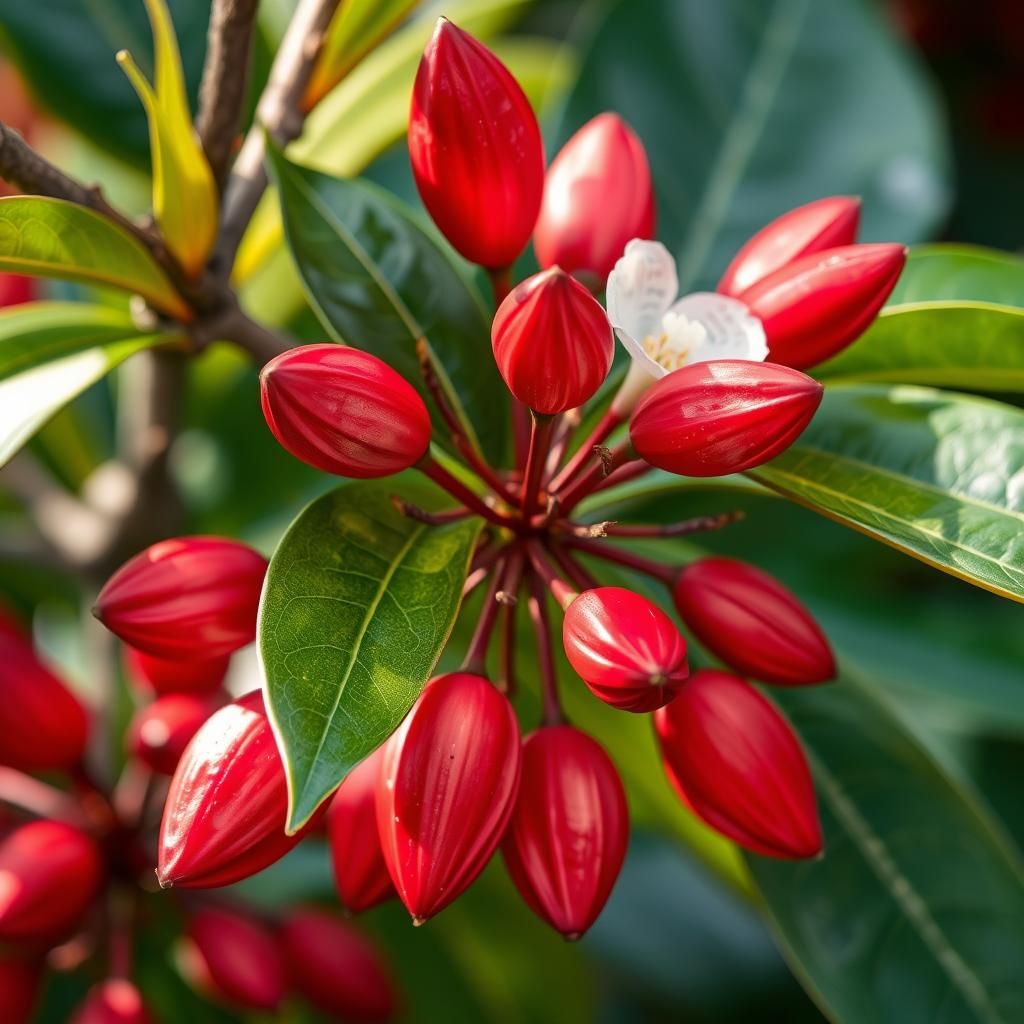Ultimate Guide to Caring for an Syzygium Smithii: Tips and Best Practices

Syzygium Smithii, commonly known as the Lilly Pilly, is a versatile and attractive plant that can enhance any garden or landscape. Whether you’re a seasoned gardener or a novice looking to green your space, understanding how to care for this evergreen species is crucial for ensuring its health and vibrancy. This ultimate guide delves into essential tips and best practices for nurturing your Syzygium Smithii, covering aspects such as ideal growing conditions, watering, pruning, and pest management. By following these guidelines, you can enjoy a flourishing Lilly Pilly that not only beautifies your environment but also thrives year after year.
Caring for Syzygium Smithii: Essential Tips
Caring for the Syzygium Smithii, also known as the Australian Brush Cherry, involves a combination of suitable environmental conditions, proper watering, and regular maintenance to ensure healthy growth. This evergreen shrub thrives in well-drained soil with moderate levels of organic matter. It prefers full sun to partial shade, making it versatile for various garden settings. Regular pruning is essential to maintain its shape and encourage bushier growth. Additionally, being attentive to the plant's needs, such as fertilization during the growing season and monitoring for pests, will help in sustaining its health and appearance.
Ideal Growing Conditions
The Syzygium Smithii flourishes in fertile, well-drained soil that is moderately acidic to neutral. It requires plenty of sunlight, ideally around six hours a day, and can tolerate light shade. Ensure that the environment is sheltered from strong winds and extreme temperatures, as this plant prefers a moderate climate. Implementing a layer of mulch can help retain moisture and regulate soil temperature while also suppressing weeds.
Watering Guidelines
Proper watering is critical for the health of the Syzygium Smithii. The plant should be watered deeply but infrequently to encourage deep root growth. A general rule is to water when the top inch of soil feels dry to the touch. Over-watering can lead to root rot, so it's essential to ensure that the pot or ground has good drainage. During dry spells or extreme heat, more frequent watering may be required to keep the soil consistently moist.
Fertilization Practices
For optimal growth, applying a balanced, slow-release fertilizer during the spring can provide the necessary nutrients for the Syzygium Smithii. Look for fertilizers with an N-P-K ratio appropriate for flowering plants. Additionally, supplementing with compost can enhance soil fertility and microbial activity. Avoid over-fertilizing, as it may cause salt buildup and harm the plant.
Pest and Disease Management
Monitoring for pests such as aphids and scale insects is vital for the longevity of your Syzygium Smithii. Regularly inspect the leaves for any signs of infestation. In case of an outbreak, insecticidal soaps or neem oil can be effective treatments. Fungal diseases can also affect this plant, particularly in overly humid or poorly drained conditions, so ensuring proper air circulation and water management can mitigate these risks.
Pruning Techniques
Pruning the Syzygium Smithii is essential to maintain its shape and promote bushy growth. The best time to prune is in late winter or early spring before new growth begins. Remove dead or crossing branches and thin out excessive growth to improve airflow. Always use sharp, clean pruning shears to minimize damage to the plant and reduce the risk of disease transfer.
| Aspect | Details |
|---|---|
| Soil | Well-drained, fertile, moderately acidic to neutral. |
| Sunlight | Full sun to partial shade, ideally up to six hours of sunlight. |
| Watering | Deep watering when top inch of soil is dry, avoiding over-watering. |
| Fertilization | Balanced, slow-release fertilizer in spring and occasional compost. |
| Pest Control | Regular inspection for pests, use insecticidal soap if needed. |
Do Lilly Pillies like a lot of water?

Lilly Pillies, also known scientifically as Syzygium, are a popular choice for landscaping due to their attractive foliage and ability to tolerate various conditions. When it comes to water needs, Lilly Pillies do not require excessive amounts, but they thrive best with consistent moisture.
Water Requirements of Lilly Pillies
Lilly Pillies prefer a balanced amount of water to ensure healthy growth. They need enough moisture to sustain their development, but can also be susceptible to root rot if overwatered.
- Moderate Watering: Providing moderate levels of moisture is crucial, especially during the hotter months.
- Soil Type: Well-draining soil helps avoid waterlogging, which is detrimental to root health.
- Seasonal Adjustments: Adjusting watering based on seasonality will help in meeting their needs effectively.
Signs of Overwatering
Understanding the signs of overwatering is essential to keep your Lilly Pillies healthy. Symptoms can manifest in various ways, indicating that the roots may be drowning.
- Yellowing Leaves: One of the first signs of overwatering is leaves turning yellow.
- Wilting: Ironically, overwatered plants may also experience wilting due to root suffocation.
- Root Rot: Blackened and mushy roots are a sign of serious overwatering issues.
Signs of Underwatering
Lilly Pillies can also show distress if they are not receiving enough water. It is important to catch these symptoms early.
See also:
- Dry Leaves: Leaves may become crispy and dry, indicating a lack of moisture.
- Leaf Drop: An extreme response to underwatering can result in significant leaf drop.
- Stunted Growth: Inadequate water can lead to poor growth and the overall health of the plant.
Ideal Watering Practices
To maintain optimal health for your Lilly Pillies, following specific watering practices can be beneficial.
- Deep Watering: Water the plants deeply but infrequently to encourage strong root systems.
- Mulching: Apply mulch around the base to retain soil moisture and reduce evaporation.
- Regular Monitoring: Check the soil moisture regularly to determine when watering is necessary.
Environmental Factors Affecting Water Needs
Several environmental factors can influence the water needs of Lilly Pillies, and adjusting based on these factors is essential for optimal growth.
- Climate: In hotter climates, Lilly Pillies may require more frequent watering.
- Sun Exposure: Plants in full sun will generally need more water than those in partial shade.
- Soil Structure: Sandy soils may drain quickly, necessitating more regular watering than clay soils.
Does Syzygium Australe like sun or shade?

Sunlight Requirements of Syzygium Australe
The Syzygium Australe, commonly known as the brush cherry, thrives best in full sun. This plant species prefers locations that provide six hours or more of direct sunlight each day. Sunlight is crucial for its growth, flowering, and fruiting. Here are the key aspects of its sunlight requirements:
- Full Sun Exposure: Optimal for promoting growth.
- Part Shade Tolerance: Can tolerate some shade but may not flourish as well.
- Increased Fruit Production: More sunlight typically leads to a higher yield of fruits.
Shade Tolerance of Syzygium Australe
While Syzygium Australe prefers full sun, it can also grow in shaded areas. However, it should be noted that prolonged exposure to shade can lead to stunted growth and reduced flowering. The degree of tolerance to shade influences its overall health and vigor. Consider the following points:
- Partial Shade Conditions: May survive but won’t grow as robustly.
- Adaptation Mechanism: Can adapt somewhat but with limitations.
- Monitor Growth: Observe changes in leaf color and growth rate in shaded areas.
Impact of Sun Exposure on Growth Rates
The amount of sunlight a Syzygium Australe receives plays a significant role in its growth rate. Plants exposed to ample sunlight tend to display a lush appearance and vibrant foliage. In contrast, shade-exposed specimens may grow slower and lean toward leginess as they reach for light. Key factors include:
- Growth Rate Variability: Faster growth observed in sunnier locations.
- Leaf Density: More abundant leaves under full sunlight.
- Overall Health: Healthier plants have better resistance to pests and disease.
Ideal Planting Locations for Syzygium Australe
Choosing the right planting location is critical when growing Syzygium Australe. The ideal site should provide ample sunlight while also considering potential competition with other plants for light. Here are some suggestions for optimal planting locations:
- Open Garden Spaces: Best for maximizing sunlight exposure.
- Near South or West Facing Walls: Helps receive additional sunlight duration.
- Accessibility to Water: Ensure adequate hydration, especially in sunnier spots.
Seasonal Sunlight Change Considerations
Seasonal changes can affect the amount of sunlight that Syzygium Australe receives throughout the year. These changes can impact the plant's growth and health. Understanding these variations is vital for successful cultivation. Important considerations include:
- Summer Sun Intensity: Monitor and provide shade if necessary to prevent leaf scorch.
- Winter Light Levels: Reducing leaf growth during shorter days may occur.
- Regular Assessment: Adjust planting or pruning to adapt to seasonal sunlight variations.
What is the best fertilizer for Lilly Pillys?

The best fertilizer for Lilly Pillys typically includes a balanced mix of nutrients that promote healthy growth and vibrant foliage. Lilly Pillys, scientifically known as Syzygium, are known for their lush green leaves and vibrant berries, making proper fertilization essential for optimal health. The ideal fertilizer should be rich in nitrogen, phosphorus, and potassium, which are crucial for flowering and fruiting.
Understanding Nutrient Requirements
The growth requirements of Lilly Pillys necessitate a careful balance of the key nutrients. These plants thrive with a fertilizer that meets their specific needs.
- Nitrogen: Essential for lush foliage and overall plant vigor.
- Phosphorus: Promotes strong root development and flowering.
- Potassium: Enhances fruit quality and improves disease resistance.
Types of Fertilizers Suitable for Lilly Pillys
Several types of fertilizers can benefit Lilly Pilly health; choosing between them depends on your gardening preferences and soil conditions. Common options include:
See also:
- Organic Fertilizers: Compost, well-rotted manure, or bone meal provide slow-release nutrients.
- Granular Fertilizers: Slow-release formulas designed for native plants can be effective.
- Liquid Fertilizers: Fast-acting solutions help in boosting nutrients during the growing season.
Application Timing and Frequency
Proper timing and frequency of fertilizer application are crucial for achieving maximum benefits for Lilly Pillys. Guidelines generally suggest:
- Spring Application: Fertilize in early spring to support new growth.
- Mid-Summer Boost: A second application in mid-summer can enhance blooming and fruiting.
- End of Growing Season: A final feeding in late summer prepares plants for winter.
Signs of Nutrient Deficiency
Recognizing signs of nutrient deficiencies in Lilly Pillys can help you adjust fertilization practices effectively. Common symptoms include:
- Pale Leaves: Indicating a lack of nitrogen.
- Stunted Growth: Often a sign of phosphorus deficiency.
- Weak Fruit Production: Suggesting insufficient potassium levels.
Environmental Considerations
Lilly Pillys thrive best in specific environmental conditions, which can affect fertilizer efficacy. Important considerations include:
- Soil Type: Well-drained, loamy soil is ideal for nutrient absorption.
- Climate: These plants prefer a subtropical climate, influencing their fertilizer needs.
- Watering Practices: Proper watering can enhance nutrient uptake from fertilizers.
Why are the tips of the Lilly Pilly leaves turning brown?
Lilly Pilly leaves are known for their attractive foliage but can sometimes exhibit browning tips, which can be concerning for gardeners. Understanding the underlying causes of this issue is crucial for maintaining healthy plants. Here are some of the most common reasons why the tips of Lilly Pilly leaves may be turning brown.
Environmental Stress
Environmental factors play a significant role in the health of Lilly Pilly plants. Stress from extreme conditions can lead to browning tips:
- Temperature Extremes: Sudden temperature changes can shock the plant, causing leaf damage.
- Humidity Levels: Low humidity can lead to moisture loss, resulting in browning.
- Sunlight Exposure: Excessive sunlight can scorch the leaves, leading to brown tips.
Watering Issues
Water management is essential for the well-being of Lilly Pilly plants. Both overwatering and underwatering can cause browning:
- Overwatering: Too much water can lead to root rot, restricting nutrient uptake, and causing leaf tips to brown.
- Underwatering: Insufficient water supply prevents the plant from maintaining its hydration, causing the leaves to dry out.
- Water Quality: High salt content or contaminants in the water can also result in browning leaves.
Nutrient Deficiency
Nutrient imbalances can manifest in the form of browning on Lilly Pilly leaves due to lack of essential nutrients:
- Iron Deficiency: A lack of iron can cause leaf chlorosis, leading to browning tips.
- Magnesium Deficiency: Magnesium is crucial for chlorophyll production, and its deficiency can cause leaf discoloration.
- Over-fertilization: Excessive fertilizer application can lead to salt buildup in the soil, causing root stress and browning.
Pests and Diseases
Pests and diseases can also be a significant contributor to browning tips on Lilly Pilly leaves. Regular monitoring can help mitigate these issues:
- Aphids: These pests can weaken the plant, leading to stressed leaves and browning tips.
- Fungal Infections: Fungi can attack the foliage, resulting in spots or browning edges.
- Climate-Induced Diseases: Conditions like powdery mildew can worsen under fluctuating weather conditions, leading to leaf damage.
Soil Conditions
The type and condition of the soil where Lilly Pilly is planted can significantly impact its health. Poor soil can lead to browning leaves:
- Drainage Issues: Soil that retains excess moisture can suffocate roots, leading to browning.
- Soil pH: An inappropriate pH level can affect nutrient availability and absorption.
- Compacted Soil: Compacted soil can limit root expansion and water infiltration, causing stress to the plant.
Questions from Our Readers
How often should I water my Syzygium smithii?
It is important to water your Syzygium smithii regularly, especially during its initial growth phase. Generally, you should water it every 1-2 weeks, allowing the top inch of soil to dry out between waterings. Be cautious not to overwater, as this can lead to root rot.
What type of soil is best for Syzygium smithii?
The best soil for Syzygium smithii is well-draining, rich organic matter. A mix of potting soil, perlite, and compost works well, ensuring the plant has sufficient nutrients while preventing waterlogging.
See also:
Does Syzygium smithii require direct sunlight?
Syzygium smithii thrives in bright, indirect sunlight but can also tolerate some direct sun exposure. Ideally, it should receive around 4-6 hours of light daily to maintain its growth and vibrant foliage.
How do I prune my Syzygium smithii?
Pruning your Syzygium smithii is essential for maintaining its shape and promoting new growth. You should prune during the spring, removing any dead or diseased branches and trimming back any overgrown areas to encourage a bushier appearance.

If you want to read more articles like Ultimate Guide to Caring for an Syzygium Smithii: Tips and Best Practices, we recommend you check out our Shrubs category.
Leave a Reply

Related Articles